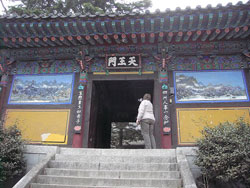Originally founded in 678, Beomeo-sa is considered one of the five greatest temples in Korea. Boasting a grand view and many ancient relics, the temple is surrounded by a lovely wisteria forest habitat. Representing one of the three jewels of Korean Buddhism, the Tongdosa Temple enshrines important Buddhist relics and its showcase altar Geumganggyedan preserves the holy remains of the Shakyamuni Buddha.

The temple stands on Kumjong-san, a mountain at the end of the T'aebaek Range which forms the backbone of the Korean peninsula. The mountain is carefully described in a Choson Dynasty geography book as having a huge rock at the summit on top of which there is a golden well which never, ever dries up.
History
Beomeo-sa is said to have been built by the Great Priest Uisang during the reign of King Munmu of the Silla Kingdom in 678 AD. The temple is one of the three largest temples in the southeastern part of the Korea, along with Haein-sa and Tongdo-sa. It is also one of the ten most famous temples of Korea's Hwaeom Sect of Buddhism (which preaches the doctrine of all encompassing harmony). Daeung-jeon (the main building) and the three-storied stone pagoda are some of the many cultural properties found here.
What to see
Ilchumun, front gate of Beomeo-sa
It is not known exactly when this gate was first constructed, although it is believed to have been rebuilt in 1614, during the reign of King Gwanghaegun, when Priest Myojeon-hwasang had several of the temple structures renovated. Records indicate that Priest Myeongheup-taesa had its two pillars replaced with stone in 1718 and that the structure was rebuilt by Priest Paegam-seonsa in 1781. It has been designated Busan Tangible Cultural Properly #2.
Daeung-jeon
Daeung-jeon is the name used for the main shrine of a Buddhist temple. Enshrined in this Daeung-jeon is Sakyamuni and two attendant Bodhisattvas. The brackets, eaves, and transom window are adroitly structured. Together with the exquisite workmanship of the colorful canopy, altar, and decorated back panel, this hall is one of the most outstanding examples of Buddhist architecture and woodwork from the Joseon period (1392-1910). It was designated Treasure.
Stone Lantern
This stone lantern was erected during the 9th century. The octagonal stone lantern (designated Busan Tangible Cultural Properly #16), followed a style unique to the Unified Silla period, consisting of a roof above the fire container, an upper stand, and a lower stand. Stone lanterns usually were placed before main temple halls or pagodas. This lantern, originally stood in front of Yonghwa-jeon, but was relocated here at the site of a removed belfry during the period of Japanese rule. This lantern features a unifoliate-lotus design on its upper and lower stands, and is in the same style as the stone lantern of Gyeongju's Bulguk-sa except that the latter has the double-leaf lotus pattern. The stone pillar of this lantern, which was added in a later year, is so poor that it causes an overall unbalance. Some subsidiary parts have been lost from the upper part of the lantern.
Three-story Stone Pagoda
This pagoda is believed to have been built during the reign of King Heungdeok of the Silla Kingdom. Built on a double foundation stone, the second and third stories are disproportionately small compared to the first story. The roofs rest on rather flat, thin four-tiered stands and the eaves are horizontal, reflecting the unique style of late Silla masonry. The only remaining roof-top finials are a finial base and bijou. It was designated Treasure.
Source
Address
546, Cheongnyong-dong, Geumjeong-gu, Busan. S.KOREA.
Tel: 051-508-3122



